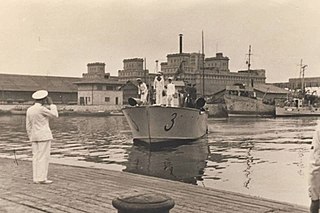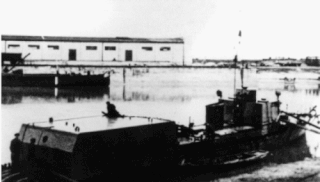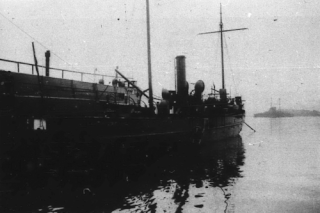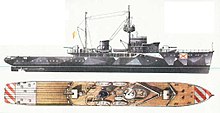Romanian service
She had four captains across the war: Alexandru Dumbravă (1941–1942), Ovidiu Mărgineanu (1942–1943), Gheorghe Harting (1943) and Anton Foca (1943–1944). [14]
Amiral Murgescu was commissioned on 2 March 1941. [15] Her first mission was between 16 and 19 June 1941, when she and two other Romanian minelayers, Regele Carol I and Aurora , laid a barrage of 1,000 mines between Cape Midia and Tuzla, to protect the main Romanian port of Constanța. When the Soviet Black Sea Fleet attacked the port on 26 June, she helped repel the attack, together with the flotilla leader Mărăști and the destroyer Regina Maria and the German coastal battery Tirpitz. The Soviet destroyer leader Moskva was sunk by Romanian mines and the cruiser Voroshilov was damaged. Amiral Murgescu also shot down two Soviet aircraft on that same day. [16] [17] Later, the Soviet submarine Shch-213 and 3 more Soviet submarines (M-58, M-34 and Shch-208) were sunk by Romanian mines near Constanța. [18] The German R-boat R-36 was also sunk by Romanian mines near Constanța in 1943. [19]
During a Soviet air raid on 23 June 1941, two of her crewmen were wounded. On a subsequent raid which took place the following day, she shot down two Soviet aircraft, her first aerial kills. [20]
On 25 June, Amiral Murgescu shot down three Soviet aircraft in 15 minutes. [21]
During a Soviet air attack on Constanța on 5 August, she shot down three more aircraft. [22]
Her next mission was between 7 and 16 October 1941. Together with the Romanian minelayers Regele Carol I and Dacia and escorted by the Romanian 250t-class torpedo boats Năluca , Sborul and Smeul, Romanian gunboats Sublocotenent Ghiculescu and Căpitan Dumitrescu and Bulgarian torpedo boats Drazki, Smeli and Hrabri, she laid four full minefields and one partial minefield along the Bulgarian coast. [23] These mines later sank 4 Soviet submarines (S-34, L-24, Shch-210 and Shch-211). [24]
In February 1942, she participated in a minelaying operation near Sulina, at the mouth of the Danube. [25]
On 24 June 1942, she laid mines near Odessa along with Dacia, while being escorted by the Romanian destroyers Regele Ferdinand and Regina Maria , the flotilla leader Mărășești , the Romanian gunboats Ghiculescu, Stihi and Dumitrescu and the Romanian torpedo boat Smeul as well as motor minesweepers of the Donau Flotilla. [26] The mines laid near Odessa later sank the Soviet submarines M-33 and M-60 [27] and the motor gunboats YA-26 and YA-27. [28]
On 29–30 October and 5 November 1942, she along with Dacia and the Romanian destroyers Regina Maria and Regele Ferdinand , the Romanian leader Mărăști , the Romanian gunboat Stihi and four German R-boats laid two mine barrages to protect Snake Island. [29] These mines sank the Soviet submarine Shch-212 on 11 December that same year. [30] [31] [32] The Soviet submarine M-31 was either sunk as well by the Romanian mine barrages near the island on 17 December, [33] or sunk with depth charges by the Romanian leader Mărășești on 7 July 1943. [34] On 1 December 1942, while the Soviet cruiser Voroshilov together with the destroyer Soobrazitelny were bombarding the island with forty-six 180 mm and fifty-seven 100 mm shells, the cruiser was damaged by Romanian mines, but she managed to return to Poti for repairs under her own power. During the brief bombardment, she struck the radio station, barracks and lighthouse on the island, but failed to inflict significant losses. [35] [36] [37] [38] [39]
On the night of 13–14 September 1943, Amiral Murgescu, escorted by two Romanian destroyers, laid mines off Sevastopol. [40] On 15 September, she along with two German auxiliary minelayers, escorted by six R-boats and the German armed ship Xanten, laid a barrage of mines that closed the mouth of the Gulf of Kherson. [41]
When not used as minelayer, Amiral Murgescu was employed as an escort ship. [42] [43] She participated in a total of 16 escort missions, mainly between Constanța and Sevastopol, between November 1942 and September 1943. One of these missions, on 19–20 July 1943, was carried out solely by her. [44] On 15 April 1944, a convoy she was escorting during the evacuation of the Crimea was attacked five times by Soviet bombers. She shot down two of them, but one of her main guns and one 20 mm gun were damaged. [45] [46]
On 12 May 1944, she was the last Romanian warship to leave Crimea during the evacuation of the peninsula by the Axis. Commanded by Lieutenant Commander Anton Foca, she evacuated about 1,000 troops, including the highly decorated German General Walter Hartmann. [47]
On 25–26 May, she and Dacia, escorted by the destroyer Regina Maria, the leader Mărășești, the torpedo boats Sborul and Smeul and the motor torpedo boats Vedenia and Viscolul , laid another barrage of mines off Sulina to reinforce the existing one. [48] The mines laid off Sulina sank the German S-boat S-148 on 22 August 1944. [49]
On 29 May 1944, she was decorated with the Order of the Star of Romania. She was also decorated with the Order of the Romanian Crown. [50] [51]

The Romanian Naval Forces is the principal naval branch of the Romanian Armed Forces and operates in the Black Sea and on the Danube. It traces its history back to 1860.

The Crimean offensive, known in German sources as the Battle of the Crimea, was a series of offensives by the Red Army directed at the German-held Crimea. The Red Army's 4th Ukrainian Front engaged the German 17th Army of Army Group South Ukraine, which consisted of Wehrmacht and Romanian formations. The battles ended with the evacuation of the Crimea by the Germans. German and Romanian forces suffered considerable losses during the evacuation.

Horia Macellariu was a Romanian rear admiral, commander of the Royal Romanian Navy's Black Sea Fleet during the Second World War.

Operation München was the Romanian codename of a joint German-Romanian offensive during the German invasion of the Soviet Union in World War II, with the primary objective of recapturing Bessarabia, Northern Bukovina and the Hertsa region, ceded by Romania to the Soviet Union a year before. The operation concluded successfully after 24 days of fighting. Axis formations involved included the Romanian Third and the Fourth Armies and the German Eleventh Army. The invasion was followed by a genocide against the Jewish population of Bessarabia.

The Battle of Jibrieni was an attack on 17 December 1941 by a Soviet submarine on an Axis convoy and its Romanian escorts off the coast of the Romanian village of Jibrieni. The engagement ended with the sinking of the attacking Soviet submarine M-59.
The Romanian Navy during World War II was the main Axis naval force in the Black Sea campaigns and fought against the Soviet Union's Black Sea Fleet from 1941 to 1944. Operations consisted mainly of mine warfare, but there were also escort missions and localized naval engagements. The largest naval action fought by the Romanian Navy was the 26 June 1941 Raid on Constanța, and its most extensive operation was the 1944 evacuation of the Crimea.

NMS Mihail Kogălniceanu was a Brătianu-class river monitor of the Romanian Navy. She saw service in both world wars, being the most successful vessel in her class of four ships. Like her three sisters, she was initially built as a river monitor, but in early 1918, she was converted to a sea-going monitor. During the Second Balkan War, she supported the Romanian crossing of the Danube into Bulgaria. During World War I, she carried out numerous bombardments against the Central Powers forces advancing along the shore of the Danube and carried out the last action of the Romanian Navy before the 11 November 1918 armistice. She later fought successfully against Bolshevik naval forces during the early months of the Russian Civil War, helping secure the Budjak region. During the interwar period, she contributed to the suppression of the Tatarbunary Uprising and was rearmed with longer main guns towards the end of the 1930s. During World War II, she fought several engagements against the Soviet Navy in the first month of the Eastern Front, but was ultimately sunk by Soviet aircraft shortly after Romania ceased hostilities against the Soviet Union, on 24 August 1944.

NMS Constanța was a submarine tender of the Romanian Navy. She was commissioned in 1931 and fought in the Second World War, being scrapped in 1977.

NMS Viscolul was the most successful and the longest-serving motor torpedo boat of the Romanian Navy during the Second World War. She supported the Siege of Odessa and took part in the action of 9 July 1941.

NMS Sublocotenent Ghiculescu was a specialized ASW gunboat of the Romanian Navy. Initially built as a French warship in late World War I, she was purchased by Romania in 1920 and fought during World War II, sinking two submarines and one motor torpedo boat. After 1 year of Soviet service, she was returned to Romania and served as a survey vessel until 2002.

The Soviet Black Sea Fleet during the first years of the Black Sea campaigns (1941–44) conducted raiding operations along the Western coast of the Black Sea aimed to disrupt Axis communications and supplies by sea.

The action of 26 June 1941 consisted in an engagement between the navies of the Soviet Union and the Kingdom of Romania, taking place on the Chilia branch of the Danube Delta, near the commune of Ceatalchioi. The action resulted in a Romanian victory and the withdrawal of the Soviet vessels, one of them being damaged and later captured.

The OMm35 class was a group of two small minelayers of the Czechoslovakian Navy. They were captured by Germany in 1939 and transferred to the Romanian Navy in 1941. The two vessels were then captured by Soviet forces in September 1944, their subsequent fates being unknown.

NMS Aurora was a small minelayer of the Romanian Navy. After initially serving in the Austro-Hungarian Navy during World War I and later in the French Navy, she was transferred to Romania and fought during World War II, being sunk in July 1941.
The Number 31 class was a group of four small multi-purpose motor launches of the Royal Romanian Navy. They served on the Danube and in the Black Sea aboard the escort minelayer Amiral Murgescu.
The Romanian Danube Flotilla is the oldest extant naval force on the Danube, dating since 1860, when the Romanian Navy was founded. It saw service during most of the wars involving Romania, and was the most powerful river naval force in the world during the Interwar period.
Submarine warfare in the Black Sea in World War II during 1942 involved engagements between primarily submarines of the Soviet Black Sea Fleet attacking Axis merchantmen defended by Romanian and German naval warships. These engagements were a part of the Black Sea campaigns between Axis and Soviet naval forces.

Between 1941 and 1944, Romania held control over much of the Ukrainian Black Sea coast East of the Crimea. This was acquired during Operation Barbarossa. The Romanian conquest of the Soviet Western Black Sea coast started in July 1941 during Operation München and ended in October that year, after the Siege of Odessa. In the aftermath of these actions, Romania (re)acquired two new sectors of coastline: the Bessarabian coast and the Transnistrian Coast. The latter was lost in April 1944, but the former was successfully defended until August 1944.

















